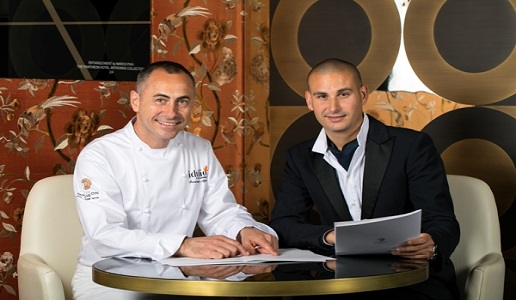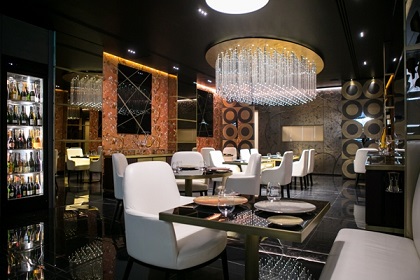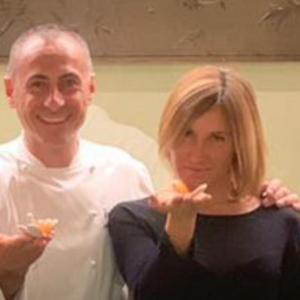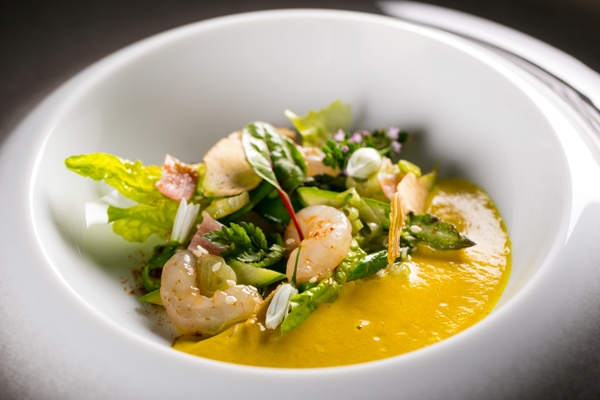Idylio, Francesco Apreda’s latest challenge

The renowned Neapolitan chef has brought his experiences in Japan to a new project, the Idylio restaurant inside The Pantheon Iconic Rome Hotel.
Precise spices, distinct flavors and crossovers. The place has changed, the name has changed but the enthralling experience of a cuisine that incorporates travels, experiences and suggestion has not changed.
Nor has the smile of Francesco Apreda changed, always sunny and welcoming, with his aquamarine eyes twinkling as he ushers you into his new home, Idylio, a restaurant inside the five-star Pantheon Iconic Rome Hotel, part of the Trident Collection group. Although it is just a stone’s throw from the Pantheon, tucked away amid small steets in the historic center, it has an Oriental, Asian feel to it, a mix of Naples, Rome, Tokyo and Mumbai.

Before entering the gourmet temple, a visit to the Divinity terrace on the hotel’s next to last floor is a must. It has a view over the dome of the Pantheon, the Sant’Ivo alla Sapienza steeple, Borromini’s jewel, and the rooftops of Rome. The atmosphere seems suspended, interrupted here and there by a passing seagull, the whisper of a breeze and the warm sunshine of early May. This is an ideal place for a glass of wine, a kiss, an aperitif at sunset or a summer meal. This gem set in the Roman sky will officially open soon and again Apreda’s contribution will be fundamental: carpaccios, buffalo mozzarella, Neapolitan delights and pizza.
Idylio is on the hotel’s ground floor. It does not look out over Rome but has an oriental décor, brass fixtures, elegant geometric patterns and butterflies. The multi-colored butterfly, in fact, is the symbol of this restaurant and the new professional challenge taken on by the chef.
“The butterfly represents change, evolution, taking flight on a new adventure,” Apreda tells us before we embark on our own adventure, one that is his but soon becomes ours. It is one composed of thousands of aromas and sensations that go straight to the heart, with suggestions and emotions that intertwine with one’s own memories and tastes. There are three tasting menus – one dedicated to Rome, one dedicated to the chef’s specialties and the last more seasonally based. We floated from one to the other, like butterflies or the birds depicted on the wallpaper, which jump from one branch to another. There are many homages to the capital but they are given an Asian flair. This includes, for example, the use of curried coconut milk in the Vignarola in Viaggio or Lapsang Souchong tea leaves with their intense aroma of incense. This mystic and smoky aroma for those who have travelled may recall the smell of Benares and its pyres along the Ganges River or to others that of incense in a sacristy. Dishes include Bun al Cacao and Vaccinara in Alga Nori, a tiny Molotov cocktail that explodes in the mouth and expands into a thousand nuances. The same is true of Risone con Battuto di Polipo, which Apreda says “recalls baby pastina”. In fact, it does in a way resemble baby food but the flavor plays on the sweetness of the octopus but has a spicy hot aftertaste. “I use chili pepper a lot, it is refreshes and exalts every flavor,” he explains. The octopus, on the other hand, reminded him of a day many years earlier in Japan when he watched an old street vendor fry octopus and then dip it into a dark and dense glaze.


“The cuisine that has impressed me the most is the Japanese one. I lived there for three years and ate in the best restaurants, on the street among the people and in dives. An Indian influence is also evident in my dishes. Indian cuisine is intense but nothing knocks you out more than Japan’s”. This explains his ample use of teriyaki and a spirit that is there but cannot be seen, sake.
Sake is used more than wine in the kitchen – even if the hotel’s wine cellar, with its over 600 different types, offers ample opportunity for creativity. Sake is found in every broth and even in the final dessert, a babà sponge cake soaked in sake with passion fruit and pepper.
Although sake may be the leitmotif in the kitchen, on the floor the wine from grapes and relative pairings are the responsibility Alessandro D’Andrea, who hit the bullseye with a Gottardi Pinot Noir that paired perfectly with the chef’s chicken with peppers. Apreda trusts him with the pairings that not only include wine but also some interesting ones like gin flavored with rose and cardamom paired with a cardamom-based dessert. Francesco, on the other hand, is a big fan of French bubbly but recently has fallen in love with Friuli Sauvignon with its “salinity and freshness”. In his cuisine, which is light on salt, this wine is not just one to accompany the dish but is almost an ingredient to counterbalance the others, to exalt, through a simple pairing, the salinity in the food. The iodine element is intrinsic to his cuisine because, amid the Japanese and Indian influences, it reflects his ntive Neapolitan soul.
“What is the most Neapolitan ingredient for you?,” we ask him.
“The sea”.

 Italiano
Italiano









